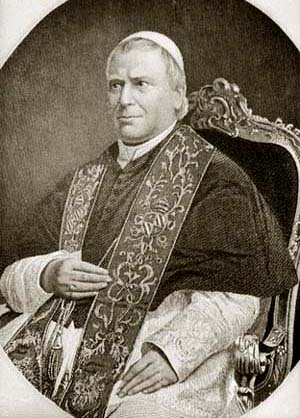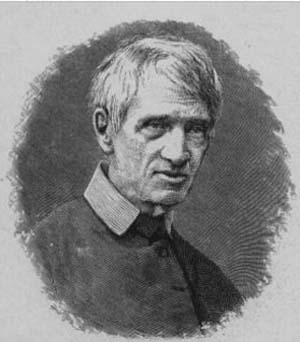 |
Traditionalist Issues
Newman and the Pope - Part II
'The Syllabus Does Not Represent
The Mind of the Pope'
James Larson
To analyze Newman’s position on The Syllabus of Errors, it is important to first place things in context.
The Syllabus of Errors of Pope Pius IX, sent to all the Bishops of the world, along with the encyclical Quanta Cura (December 8, 1864), amounted to a declaration of war against the revolutionary world of the 19th century. This was a time when revolutions were being waged in every sphere of human thought, life and activity against Christ and His Church.
The vast scope of the errors condemned is reflected in its division into 10 sections, each section representing a different area of human thought or activity. These are labeled as follows:

A century of revolutions.
Above, the 1848 revolution in Berlin |
- Pantheism, Naturalism and Absolute Rationalism;
- Moderate Rationalism;
- Indifferentism and Latitudinarianism;
- Socialism, Communism, Secret Societies, Bible Societies and Liberal Clerical societies;
- Errors concerning the Church and her Rights
- Errors about Civil Society, considered both in itself and in its relation to the Church;
- Errors concerning Natural and Christian Ethics;
- Errors concerning Christian Marriage;
- Errors regarding the civil power of the Sovereign Pontiff;
- Errors having reference to Modern Liberalism.
In considering the Syllabus in its larger context, it is also important to realize that the pontificate of Pius IX’s successor, Leo XIII, was largely focused upon fleshing out these condemnations through an array of social encyclicals covering all these areas of thought and activity. Pius X, Leo XIII’s successor, brought this analysis and condemnation of modern errors to fruition in both his Encyclical Pascendi and in his own Syllabus against the Errors of Modernism.
It is therefore impossible to overestimate the importance of Pius IX’s Syllabus for our understanding of the ideas, techniques and activities of the forces of evil in the modern world. It is a tool for us to acquire those intellectual and moral weapons necessary for the Church’s defense and counter-attack against these immensely destructive errors.
On the other hand, to undermine the authority and importance of the Syllabus in any way can only serve the purpose of aiding and abetting these same forces of evil. As we shall see, John Henry Newman used virtually every subterfuge conceivable to accomplish just such a task.
Undermining the Syllabus
One of the things characteristic of the Modernist mind is that, to a large extent, it wants to leave alone the “bigger” mysteries of our Faith, the doctrines of the Trinity or of the Incarnation, for instance. It is otherwise with the truths that oppose the 80 propositions condemned by the Syllabus. Here, the “illative sense” of the dominant worldview, with which the ecumenist wishes to enter into dialogue and dialectical progress, is directly confronted and condemned. ...

Newman: Pius IX has nothing to do with the Syllabus |
Thus, a person could hardly find himself in a position of being more of a sign of contradiction to the world and modern culture than by fully assenting to and embracing the Syllabus. And this is why the Syllabus is such a nemesis to the Liberal and Modernist mind. It lays bare precisely those principles and ideas that are on the cutting edge of the “vitality” of the modern world, and effectively burns them at the stake.
It puts the ecumenist out of a job, it puts the non-Thomist out of a job, and it would have put Newman out of a job if the Catholics around had taken it with the substantial seriousness that it deserved. Few did. Cardinal Manning was one of them. Newman eventually won the battle, and Manning lost.
Newman’s “definitive” response to the Syllabus of Pius IX is to be found in Section 7 of the Letter to the Duke of Norfolk (1875), usually considered his last major work. It is with an analysis of this work that we will be concerned here.
Newman does everything possible to undermine the physical and moral connection of the Syllabus to the Pope. He says such things as:
- “Viewed in itself, it is nothing more than a digest of certain errors made by an anonymous writer.”
- “There is not a word in it of the Pope’s own writing.”
- “There would be nothing on the face of it to show that the Pope had ever seen it, page by page, unless the imprimatur implied in the Cardinal’s letter had been an evidence of this.”
- “But the Syllabus makes no claim to be acknowledged as the word of the Pope.”
- “The Syllabus cannot even be called an echo of the Apostolic Voice.”
Now, of course, none of the above statements are quoted in context. In point of fact, the context makes them appear even worse. This “context” is constituted by the fact that the Syllabus was long in preparation, and a project very close to the heart and mind of Pius IX (and also Cardinal Pecci, the future Pope Leo XIII).
The paragraphs below are taken from the 1912 Catholic Encyclopedia. I quote it in its entirety because it clearly “puts the lie” to Newman’s contention that the Syllabus was not the “Voice” of Pius IX:

Newman ignores the evidence the Syllabus was directed by the Pope |
"The first impulse towards the drawing up of the Syllabus of Pius IX came from the Provincial Council of Spoleto in 1849. Probably on the motion of the Cardinal Archbishop of Perugia, Pecci (later on Leo XIII), a petition was laid before Pius IX to bring together under the form of a Constitution the chief errors of the time and to condemn them. The preparation began in 1852.
“At first Pius IX entrusted it to Cardinal Fornari, but in 1854 the commission which had prepared the Bull on the Immaculate Conception took matters in hand. It is not known how far the preparation had advanced when Gerbet, Bishop of Perpignan, issued, in July, 1860, a Pastoral Instruction on various errors of the present to his clergy. With Gerbet's Instruction begins the second phase of the introductory history of the Syllabus.
“The Instruction had grouped the errors in 85 theses, and it pleased the Pope so much that he set it down as the groundwork upon which a fresh commission, under the presidency of Cardinal Caterini, was to labor. The result of their work was a specification, or cataloging, of 61 errors with the theological qualifications.
“ In 1862 the whole was laid for examination before 300 bishops who, on the occasion of the canonization of the Japanese Martyrs, had assembled in Rome. They appear to have approved the list of theses in its essentials. Unfortunately, a weekly paper of Turin, Il Mediatore, hostile to the Church, published the wording and qualifications of the theses, and thereby gave rise to a far-reaching agitation against the Church. The Pope allowed the storm to subside; he withheld the promulgation of these theses, but kept to his plan in what was essential.
“The third phase of the introductory history of the Syllabus begins with the appointment of a new commission by Pius IX; its most prominent member was the Barnabite Bilio (afterwards Cardinal) . The commission took the wording of the errors to be condemned from the official declarations of Pius IX and appended to each of the 80 theses a reference indicating its content, so as to determine the true meaning and the theological value of the subjects treated. With that the preparation for the Syllabus, having occupied 12 years, was brought to an end.
“Of the 28 points which Cardinal Fornari had drawn up in 1852, 22 retained their place in the Syllabus; of the 61 theses which had been laid before the Episcopate for examination in 1862, 30 were selected. The promulgation, according to the original plan, was to have taken place simultaneously with the proclamation of the dogma of the Immaculate Conception.
“In the event it was 10 years later (8 December 1864) that Pius IX published the Encyclical Quanta Cura, and on the same day, by commission of the Pope, the Secretary of State, Cardinal Antonelli, sent, together with an official communication, to all the bishops the list of theses condemned by the Holy See. The title of the document was: A Syllabus containing the most important errors of our time, which have been condemned by our Holy Father Pius IX in Allocutions, Consistories, Encyclicals and other Apostolic Letters."
This effort to deny the connection of the Syllabus to the mind and will of Pius IX is part of the larger scheme to deny any dogmatic force to its condemnations. In fact, Newman simply and emphatically states, “The Syllabus then has no dogmatic force.”
His efforts to establish this fallacy will be examined in the next article.
Continued

Posted February 18, 2012
James Larson first published this article
on his webpage War against Being

Related Topics of Interest
 Newman's Duplicitous Position on Papal Infallibility Newman's Duplicitous Position on Papal Infallibility
 The Liberal Card. Newman Americans Don’t Know The Liberal Card. Newman Americans Don’t Know
 Newman Regrets the Syllabus Newman Regrets the Syllabus
 Newman Supports the Liberal Agenda against Pius IX Newman Supports the Liberal Agenda against Pius IX
 Newman Suspect in Rome Newman Suspect in Rome
 Doubts about the Beatification of Card. Newman Doubts about the Beatification of Card. Newman
 A Pain in the Back? A Pain in the Back?

Related Works of Interest
|
|
Traditionalism | Hot Topics | Home | Books | CDs | Search | Contact Us | Donate

© 2002- Tradition in Action, Inc. All Rights
Reserved
|
 |
|